
1/3/2017
1
Chapter 4
Segmentation, Targeting and
Positioning in B.M
www.dinhtienminh.net
DINH Tien Minh (Ph.D.)
University of Economics HCMC
Objectives
2
Know market segmentation, its benefits and
limitations, and requirements of effective
segmentation.
Learn to select the target market segments
and target-market strategies.
Learn to develop effective positioning
strategies.
Outlines
4.1 Market Segmentation
4.2 Selecting the Target Segments
4.3 Positioning
3

1/3/2017
2
4
4.1. Market segmentation
Definition: Market segmentation is the
process of dividing a market into groups of
customers who have similar requirements for
a product or service offering.
Nguồn: Krishna K Havaldar (2010), Business Marketing, McGraw Hill, 3rd
edition, p42
5
4.1. Market segmentation (cont’)
Business Market Segmentation Process
Identify Segmentation Variables
Collect Data
Analyze Data
Form Segments
Nguồn: Lau Geok Theng (2007), Business Marketing –An Asian Perspective,McGraw Hill,, pp 96.
6
4.1. Market segmentation (cont’)
Segmenting and Targeting Framework
Conduct Marketing research to collect data on
buying firms and competition
Identify Macro-segments based on analysis of data
Select those Macro-segments which satisfy
company objectives and resources
(More)

1/3/2017
3
7
4.1. Market segmentation (cont’)
Nguồn: Yoram Wind & Richard Cardozo, “Industrial Market Segmentation”, Industrial Marketing Management, 3, 2, (April, 1974), pp 153-66.
If yes, select the target
Macro-segments based
on specific criteria
Stop, and use the Macro-
segments as target
segment
Evaluate each selected Macro-
segment on whether it explains the
differences in buying decision.
If no, identify within each Macro-
segment, meaningful Micro-
segments.
Select the target Micro-segments
based on earlier specified criteria
Profile target segments based on
buying organization and Decision
Making Unit characteristics
8
4.1. Market segmentation (cont’)
Identifying variables used for segmenting
Variables Examples
Macro-variables
1. Type
of industry,
type of customer
-
Which industries should we market our products or
service?
Mining,
chemical, rubber, textile, etc.
-
Type of customer includes Government,
Commercial,
Cooperative,
and Institutional.
2. Company size, usage
rate
-
What size of company should we focus on? Based on
sales
potential
(or usage), market is segmented by large, medium
and
small
(or A, B, and C) size customers.
3. Customer
location,
geographic area
-
What geographical areas should we concentrate on?
Customers
located
nearer to factory, of clusters of customers located in
various
urban
areas.
4. End
-use or
application benefits of
products
-
Should we focus on certain specific end-uses of applications
of
our
product instead of all the uses or applications? Each product
or
service
has different benefits, uses or applications.
9
4.1. Market segmentation (cont’)
Micro-variables
5.
Buying situations:
New task,
Modified
rebuy
, Straight rebuy
-
Should we serve customers who need more information, help,
or
discussion
in decision making process from the suppliers?
6.Organizational
capabilities
-
Should we concentrate on customers who need financial
support
(more
credit), more service (prompt or quick deliveries),
or
technical
support?
7.Purchasing
policies
-
Should we focus on customers who prefer competitive
bidding,
market
based negotiated prices, turn-key contracts,or
service
contracts?
8.Purchasing
criteria
-
Should we serve the customers who seek quality, service, or price?
9.Personal
characteristics
-
Should we focus on customers based on the personal
characteristics
of
buying-center members such as risk-takers, risk-avoiders,
or
personal
motives?
Nguồn: Krishna K Havaldar (2010), Business Marketing, McGraw Hill, 3rd edition, p147.

1/3/2017
4
10
Example of the Business Market
Segmentation Process
Automotive
(Heavy
Users)
Aerospace
(Medium
Users)
Large
Buying
Center
Small
Buying
Center
Team
Selling
Individual
Selling
Design
Engineers
Plant
Managers
Technology
Focus
Delivery and
Quality
Focus
Nguồn: Lau Geok Theng (2007), Business Marketing –An Asian Perspective,McGraw Hill,, pp 98.
11
4.1. Market segmentation (cont’)
Benefits, Limitations and Requirements of
effective segmentation:
What are the Benefits?
•Enable to compare marketing opportunities of
different market segments (needs, competition,
satisfaction levels).
•Develop separate marketing programs or plans.
•The budgeted allocation of resources can be done
effectively.
12
4.1. Market segmentation (cont’)
Benefits, Limitations and Requirements of
effective segmentation (cont’):
What are the Limitations?
•Increase in marketing expenses (inventory carrying
cost, adv, transportation…).
•Difficulty in segmenting due to existence of great
differences in buying practices, customer
characteristics, product applications…

1/3/2017
5
13
4.1. Market segmentation (cont’)
Benefits, Limitations and Requirements of
effective segmentation (cont’):
What are the Requirements?
•Measurable
•Substantial
•Accessible
•Differentiable
18
4.2. Selecting the target segments
After evaluating several market segments,
the company must select its target
segments by using the Simple Matrix
System (SMS) method.
19
4.2. Selecting the target segments (cont’)
Simple Matrix System (SMS)
Segments
Factors
Automotive
Bicycle
Boiler Furniture Bus body
Building
Size
(US
million)
600
500
300
250
200
Growth (in %)
20
10
10
7
10
Profitability
Good
Good
Good
Low
Low
No
. of
competitors
3
4
3
10
8
Major
competitors’
strengths
Product
quality and
timely
delivery
Product
quality
and
timely
delivery
Availability
of special
raw material
with 2
competitors
Low prices
from small
-
scale
manufacturers
Low prices
from small
-
scale
manufacturers


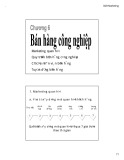
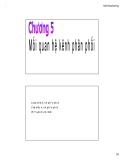
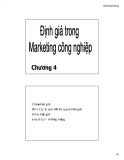
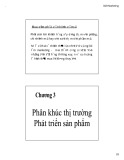
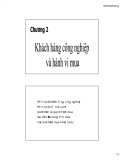
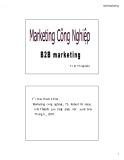
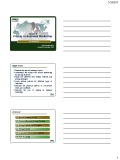
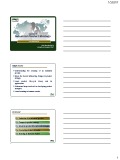
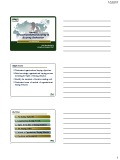


![Tối ưu hóa hiệu suất hệ thống: Bài thuyết trình [Chuẩn nhất]](https://cdn.tailieu.vn/images/document/thumbnail/2025/20251107/hiepdz2703@gmail.com/135x160/35941762488193.jpg)




![Bài giảng Quản trị chất lượng trong công nghiệp thực phẩm [chuẩn nhất]](https://cdn.tailieu.vn/images/document/thumbnail/2025/20250805/vijiraiya/135x160/637_bai-giang-quan-tri-chat-luong-trong-cong-nghiep-thuc-pham.jpg)

![Đề cương bài giảng Kỹ năng hoạt động công nghiệp [mới nhất]](https://cdn.tailieu.vn/images/document/thumbnail/2025/20250715/kimphuong1001/135x160/76971752564028.jpg)


![Bài giảng Kỹ thuật điều độ trong sản xuất và dịch vụ [mới nhất]](https://cdn.tailieu.vn/images/document/thumbnail/2025/20250630/dcbaor/135x160/13121751251866.jpg)


